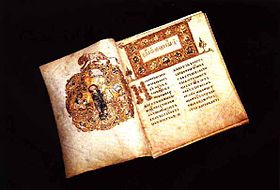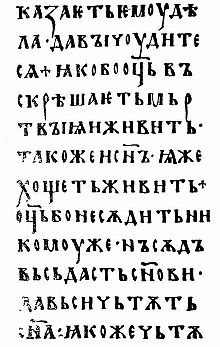- Ostromir Gospels
-
 The Ostromir Gospels, written in the Church Slavonic with many vernacular words, is famous for its brilliant miniatures. The opening of the Gospel of Saint John, with his Evangelist portrait.
The Ostromir Gospels, written in the Church Slavonic with many vernacular words, is famous for its brilliant miniatures. The opening of the Gospel of Saint John, with his Evangelist portrait.
The Ostromir Gospels (Russian: Остромирово Евангелие) is the second oldest dated East Slavic book (it was considered the first before the Novgorod Codex was discovered in 2000). It was created by deacon Gregory for his patron, Posadnik Ostromir of Novgorod, in 1056 or 1057, probably as a gift for a monastery.
Contents
The book
The book is a illuminated manuscript Gospel Book lectionary containing only feast-day and Sunday readings. It is written in a large uncial hand in two columns on 294 parchment sheets of the size 20 x 24 cm. Each page contains eighteen lines. The book is concluded by the scribe's notice about the circumstances of its creation.
Three full page evangelist portraits survive, by two different artists, and many pages have decorative elements. The close resemblance between this and the equivalent pages in the Mstislav Lectionary suggests they are both based on a common prototype, now lost. The two artists who produced the evangelist portraits were both heavily influenced by Byzantine models, but the style of the portraits of Saints Mark and Luke seems to derive from Byzantine enamelled plaques rather than manuscripts.
More early Russian manuscripts have survived from Novgorod, which was never occupied by the Mongols, than any other centre.[1]
Later history
It is thought that the book was taken from one of Novgorod monasteries to the personal collection of the Russian tsars in the Moscow Kremlin, where it was first registered in 1701. Peter the Great ordered it to be taken to St. Petersburg, where there was no mention of it until 1805, when it was discovered in the dressing room of the late Catherine the Great.
The Gospels were deposited in the Imperial Public Library in St Petersburg, where it remains. Alexander Vostokov was the first to study it in depth, demonstrating that the Church Slavonic of the manuscript reflects the Old East Slavic linguistic background of the scribe. The first facsimile edition was published under Vostokov's supervision in 1843.
In 1932, the gem-studded book-cover induced a plumber to break into a case, remove and steal the binding, and hide the parchments behind a bookcase. Although the book was quickly recovered, no replacement binding has been provided to date.
See also
- Novgorod Codex (first quarter of 11th c.) | Svyatoslav's Miscellanies (1073, 1076) | Archangel Gospel (1092) | Mariinsky Gospel (11th cent.) | Mstislav Gospel (1117) | Yuriev Gospel (1119) | Halych Gospel (1144) | Dobrila Gospel (1164) | Pantaleon Gospel (12th cent.) | Eusebius Gospel (1282) | Chelm Gospel (13th cent.)
References
- ^ Popova, Olga, Russian Illuminated Manuscripts, Thames & Hudson, London (or Braziller NY), 1984, nos 1-5, & pp 5-9
External links
Categories:- 1050s books
- East Slavic manuscripts
- Eastern Orthodoxy
- Gospel Books
- Kievan Rus'
- Novgorod Republic
- Russian culture
- Ukrainian culture
- National Library of Russia collection
- 11th-century biblical manuscripts
Wikimedia Foundation. 2010.

